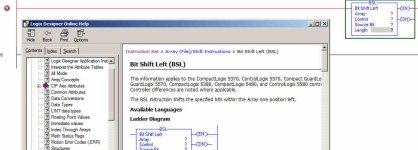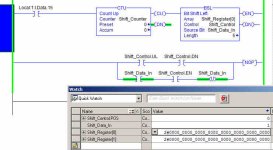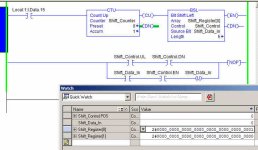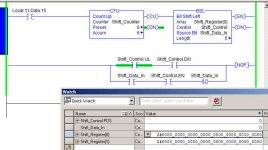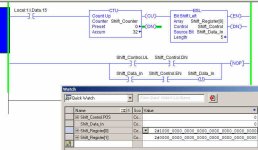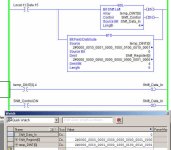AutomationTechBrian
Lifetime Supporting Member
Sidenote: One of my favorite lessons back in school was learning about BSL in RSLogix 500, and making it work in a simulator. I've been waiting about 11 years for the opportunity to use it... and here it is! But I'm having trouble with it.
I made a test routine to play around with it in Studio 5000, v32. I only need 5 bits, so my array size is 1. I can't find the help file for "Control" data type, so I just created the test "control" tag and left it blank. I tied the "Source Bit" to a switch using a local input. And I only need 5 bits for the "Length". I put an XIC contact on that rung, and tied it to another local input. Then I tried it out. It seemed to work great... until I found that it kept writing to the DINT after I passed the 5th bit. I'm going to use the value of the Array to change which timer to use between cycles, and I expected the values to drop off after the 5th bit. What am I doing wrong? I tried a BSR, and that works great... starts at the 5th bit and works down to 1 and drops off. I believe I should be able to have BSL drop values beyond the 5th bit as well. What am I doing wrong?
I have limited internet for a couple more days, which is frustrating for trying to research things like this.
I made a test routine to play around with it in Studio 5000, v32. I only need 5 bits, so my array size is 1. I can't find the help file for "Control" data type, so I just created the test "control" tag and left it blank. I tied the "Source Bit" to a switch using a local input. And I only need 5 bits for the "Length". I put an XIC contact on that rung, and tied it to another local input. Then I tried it out. It seemed to work great... until I found that it kept writing to the DINT after I passed the 5th bit. I'm going to use the value of the Array to change which timer to use between cycles, and I expected the values to drop off after the 5th bit. What am I doing wrong? I tried a BSR, and that works great... starts at the 5th bit and works down to 1 and drops off. I believe I should be able to have BSL drop values beyond the 5th bit as well. What am I doing wrong?
I have limited internet for a couple more days, which is frustrating for trying to research things like this.




